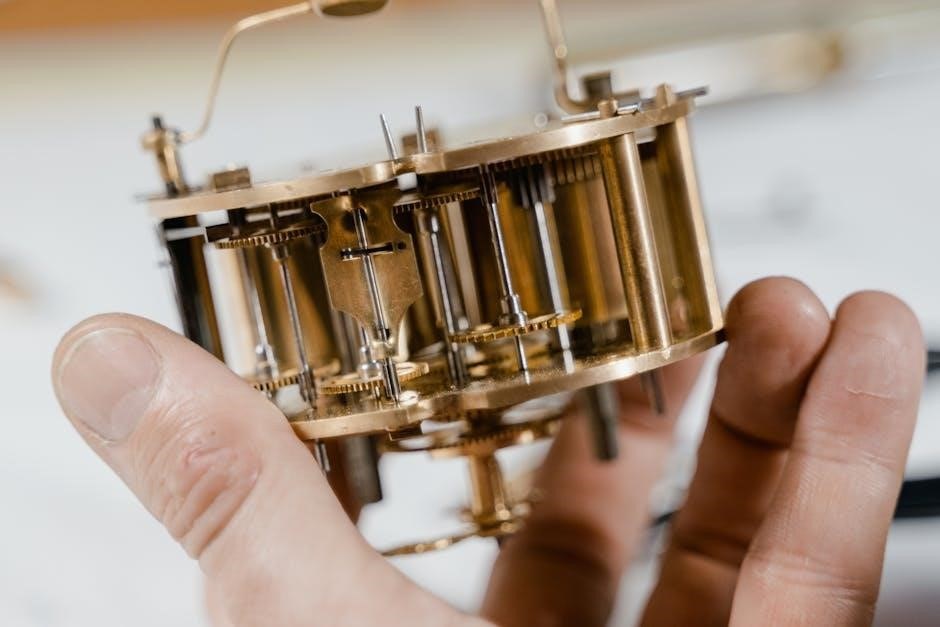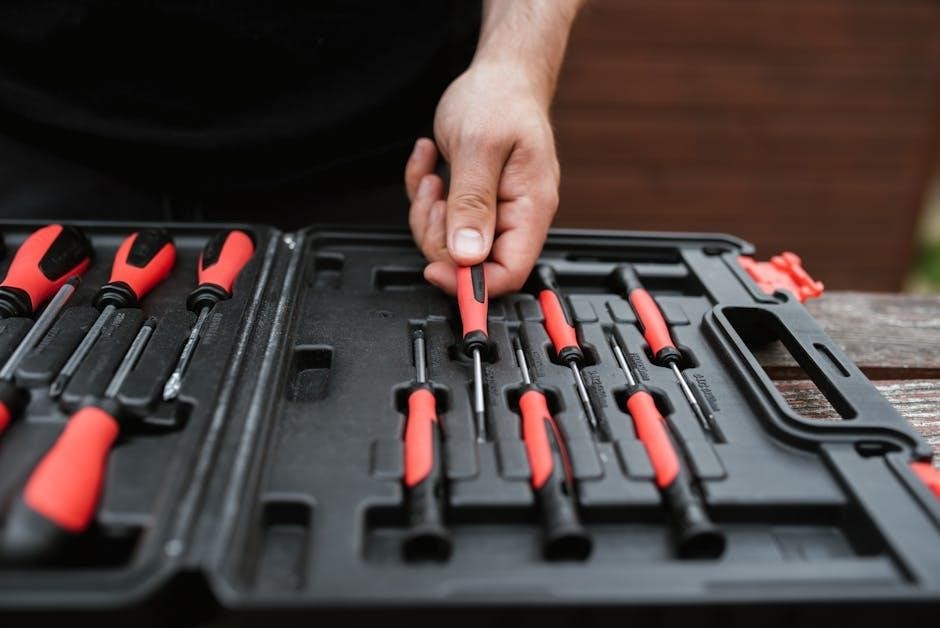KitchenAid refrigerator repair manuals are essential resources for troubleshooting and maintaining your appliance․ These guides provide detailed instructions, diagnostic tools, and repair solutions for common issues․ They empower users to address problems confidently, whether through DIY fixes or professional assistance․
Overview of the Importance of Repair Manuals
Repair manuals are crucial for empowering users to address issues effectively․ They provide clear instructions, reducing reliance on professionals and saving costs․ These guides enhance safety by outlining proper procedures, preventing further damage․ Access to troubleshooting tips and maintenance schedules ensures optimal appliance performance․ They are indispensable for extending the lifespan of your KitchenAid refrigerator, offering comprehensive support for DIY enthusiasts and professionals alike․
Key Features of the KitchenAid Refrigerator Repair Manual PDF
The KitchenAid refrigerator repair manual PDF offers comprehensive guides for troubleshooting and fixing common issues․ It includes detailed diagrams, step-by-step instructions, and lists of essential tools․ The manual covers various models, ensuring compatibility and relevance․ With clear technical specifications and diagnostic tips, it empowers users to address problems effectively, whether they are simple fixes or complex repairs․

Where to Find the KitchenAid Refrigerator Repair Manual PDF
The KitchenAid refrigerator repair manual PDF can be found on the official KitchenAid website or through third-party manual libraries․ Ensure you have your model number for accurate downloads․
Official KitchenAid Website and Resources
The official KitchenAid website offers authentic repair manuals and resources for your refrigerator․ Visit www․kitchenaid․ca or call 1-800-807-6777 for assistance․ Ensure to have your model and serial number ready, typically found on the inside wall of the fridge․ Official resources provide reliable, comprehensive guides and support, making them the most trusted source for repair needs․
Third-Party Websites and Manuals Libraries
Third-party websites like ManualsLib and ManualsOnline offer a wide range of appliance manuals, including KitchenAid refrigerator repair guides․ These platforms aggregate manuals from various brands, making them accessible for download․ Additionally, online forums and communities often share links to these resources, though it’s crucial to verify their reliability and safety to avoid malware risks․ Always ensure the manual matches your specific refrigerator model for accurate information․
Understanding the Content of the Repair Manual
The KitchenAid refrigerator repair manual provides a comprehensive guide, including diagnostic tools, technical specifications, and detailed repair procedures․ It helps users identify and address common issues effectively․
Structure and Organization of the Manual
The KitchenAid refrigerator repair manual is logically structured for easy navigation․ It typically begins with a table of contents, followed by safety precautions and diagnostic guides; Detailed sections cover troubleshooting, repair procedures, and parts replacement․ Clear diagrams and step-by-step instructions ensure clarity, making it a comprehensive resource for both DIY enthusiasts and professional technicians․
Technical Specifications and Diagnostic Tools
The KitchenAid refrigerator repair manual PDF includes detailed technical specifications, such as part numbers, wiring diagrams, and error codes․ Diagnostic tools guide users through troubleshooting processes, helping identify issues like faulty compressors or malfunctioning sensors․ These resources ensure accurate repairs and compatibility with various KitchenAid models, aiding both DIY enthusiasts and professionals in resolving appliance problems effectively․

Common Issues Addressed in the Repair Manual
The manual covers refrigerator cooling problems, ice maker malfunctions, and noise issues․ It provides solutions for faulty compressors, defrost systems, and faulty temperature sensors, ensuring optimal performance․
Refrigerator Cooling Issues and Solutions
Refrigerator cooling issues are common and can stem from faulty compressors, condenser coils, or evaporator fans․ The KitchenAid repair manual provides detailed diagnostic steps to identify malfunctions․ Solutions may include cleaning clogged coils, replacing faulty relays, or addressing refrigerant leaks․ Regular maintenance, such as checking door seals and ensuring proper airflow, can prevent cooling problems․ The manual also offers troubleshooting guides for specific error codes related to cooling performance․
Troubleshooting Ice Maker Malfunctions
Troubleshooting ice maker issues in your KitchenAid refrigerator involves checking water supply lines, ensuring the ice maker switch is on, and cleaning ice molds․ Common problems include clogged water filters, faulty sensors, or electrical connections․ Refer to the repair manual for diagnostic charts and step-by-step solutions․ Addressing these issues promptly can restore ice production and maintain your refrigerator’s efficiency․
Addressing Noise and Vibration Problems
Noise and vibration issues in KitchenAid refrigerators can often be resolved by ensuring proper installation and maintenance․ Check if the appliance is level, as imbalance can cause excessive vibration․ Inspect the compressor, condenser coils, and evaporator fan motor for malfunctions․ Clean dirty coils and ensure proper air circulation․ Address clogged defrost drains, which may contribute to noise during cycles․ Regular maintenance, like cleaning condenser coils and checking for loose parts, can prevent future issues․ If problems persist, consult the repair manual for diagnostic steps or contact a professional technician to avoid further complications․
DIY Repair vs․ Professional Service
DIY repairs are cost-effective for minor issues, while professional service is recommended for complex problems requiring specialized tools or expertise to ensure safety and effectiveness․
When to Attempt DIY Repairs
Attempt DIY repairs for minor issues like replacing water filters, cleaning condenser coils, or addressing ice maker malfunctions․ These tasks are often straightforward and outlined in the KitchenAid repair manual․ Ensure you have the necessary tools and follow safety precautions․ DIY is ideal for confident users with basic technical skills, but complex problems like compressor replacement should be left to professionals to avoid further damage or safety risks․
Knowing When to Call a Professional Technician
Some issues, like complex electrical faults or compressor failures, require specialized expertise․ If you encounter severe problems or error codes beyond your understanding, it’s wise to contact a certified technician․ They possess the tools and knowledge to diagnose and fix intricate problems safely and efficiently, ensuring your appliance operates correctly without further damage․

Essential Tools and Materials for Repair
Essential tools include multimeters, screwdrivers, and wrenches․ Materials like insulation, duct tape, and thermal paste are crucial for maintaining proper function and preventing future issues․
Basic Tools Required for Common Repairs
For common KitchenAid refrigerator repairs, essential tools include screwdrivers (Phillips and flathead), adjustable wrenches, pliers, and a multimeter for electrical checks․ Additional items like a socket set, torque wrench, and sealants may be needed․ Always refer to the manual for specific requirements․ Having these tools ready ensures efficient troubleshooting and repair, minimizing downtime and potential damage․
Specialized Tools and Materials Needed
Repairing a KitchenAid refrigerator may require specialized tools like a torque wrench for compressor repairs or a manifold gauge for refrigerant handling․ Materials such as replacement gaskets, seals, and refrigerant recharge kits are often necessary․ Ensure you have these tools and materials on hand to follow the repair manual’s instructions effectively and safely․

Safety Precautions During Repair
When repairing your KitchenAid refrigerator, always disconnect the power and handle refrigerants safely․ Wear protective gear and avoid hazardous materials to ensure a secure repair process․
Electrical Safety and Precautions
When working on your KitchenAid refrigerator, always disconnect the power supply to avoid electrical shock․ Wear insulated gloves and ensure the appliance is grounded․ Never touch electrical components with wet hands․ Use a multimeter to verify power is off before starting repairs․ Keep children away from tools and live circuits․ Follow the manual’s guidelines for safe electrical procedures to prevent accidents and ensure proper repairs․
Handling Refrigerants and Hazardous Materials
When working with refrigerants, always wear protective gear and follow safety protocols to avoid exposure․ Improper handling can lead to health risks and environmental damage․ Ensure proper disposal of hazardous materials, adhering to local regulations․ Refer to the manual for specific guidelines on refrigerant management and safety precautions to minimize risks during repairs․

Troubleshooting Guide
The KitchenAid repair manual PDF offers a step-by-step guide to diagnose common refrigerator issues․ It includes error codes, diagnostic procedures, and solutions to address malfunctions effectively․
Step-by-Step Diagnostic Procedures
Troubleshooting begins with identifying symptoms like error codes or unusual noises․ Use the manual to match issues with possible causes․ Check power supply, sensors, and components․ Follow systematic steps to isolate faults, starting with the most common issues․ Refer to diagnostic charts and test procedures in the manual to ensure accurate repairs․ Always prioritize safety and proper tools for each task․
Common Error Codes and Their Meanings
KitchenAid refrigerator repair manuals detail common error codes, such as “E1” or “SY EF,” which indicate issues like sensor malfunctions or communication errors․ Understanding these codes helps diagnose problems quickly, guiding repairs effectively․ The manual provides clear explanations and solutions, ensuring users can address issues confidently, whether through DIY fixes or professional assistance, based on the severity of the error․
Replacing Common Parts
Replacing common parts in your KitchenAid refrigerator, such as compressors or evaporator coils, requires careful adherence to the repair manual’s guidelines․ Ensure proper tools and safety precautions are in place to avoid further damage or hazards․ Always refer to the manual for specific instructions tailored to your model․
Replacing the Compressor and Condenser Coils
Replacing the compressor and condenser coils requires careful planning and specialized tools․ Ensure the appliance is unplugged and refrigerant lines are safely disconnected․ Follow the manual’s step-by-step instructions to avoid damage․ Proper alignment and tightening are crucial for optimal performance․ This complex process may necessitate professional assistance if you lack experience with refrigeration systems․
Evaporator Coil and Fan Motor Replacement
Replacing the evaporator coil and fan motor involves accessing the rear or bottom panel of your KitchenAid refrigerator․ Disconnect power, remove protective coverings, and carefully detach electrical connections․ Use a screwdriver to secure the new motor and ensure proper alignment․ Reassemble components, restore power, and test cooling performance․ Always refer to the manual for specific torque and alignment specifications to avoid airflow issues․

Maintenance Tips
Regular cleaning of condenser coils and checking door seals ensure optimal performance․ Replace water filters every 6 months and inspect evaporator fans for dust buildup․
Regular Maintenance to Prevent Issues
Regular maintenance is crucial for ensuring your KitchenAid refrigerator runs efficiently․ Clean condenser coils annually to improve cooling performance․ Check door seals for tightness to prevent air leaks․ Inspect and replace worn gaskets to maintain temperature consistency․ Schedule annual professional inspections to identify potential issues early․ Proper upkeep extends appliance longevity and prevents costly repairs․
Cleaning and Inspecting Key Components
Regular cleaning and inspection of your KitchenAid refrigerator’s key components, such as condenser coils, evaporator fans, and door seals, are crucial for optimal performance․ Clean condenser coils every 6 months to ensure proper airflow and energy efficiency․ Inspect door seals for wear and tear to maintain temperature consistency․ Refer to the repair manual for detailed cleaning instructions and maintenance schedules to prevent future issues․

Warranty and Support
Understanding your KitchenAid warranty is crucial for covered repairs․ Contact customer support with your model and serial number for assistance, ensuring compliance with warranty terms․
Understanding Your KitchenAid Warranty
Your KitchenAid warranty provides coverage for repairs and replacements under specific conditions․ It typically includes parts and labor for manufacturing defects within a set period․ To validate your warranty, ensure your appliance is registered and properly maintained․ Understanding the terms helps prevent unexpected repair costs and ensures compliance with warranty requirements for service requests․
Contacting Customer Support and Service Centers
For assistance, visit KitchenAid’s official website or call their customer support at 1-800-807-6777 in Canada․ Ensure you have your appliance’s model and serial number ready, located on the inside wall of the refrigerator․ This information is crucial for efficient service and troubleshooting, helping you resolve issues quickly and effectively․
Online Resources and Forums
Online forums and communities offer valuable insights and discussions on KitchenAid refrigerator repair․ Official KitchenAid forums and third-party sites like Repair Clinic or ApplianceBlog provide real-time support and advice․
Official KitchenAid Forums and Communities
KitchenAid’s official forums and communities offer valuable resources for users seeking repair guidance․ These platforms provide direct access to experts, verified repair manual links, and discussions with experienced users․ Members can share tips, ask questions, and find specific solutions for their KitchenAid refrigerator repair manual PDF needs, ensuring safe and effective troubleshooting․
Third-Party Repair Forums and Discussions
Third-party repair forums and discussions offer valuable insights and real-user experiences with KitchenAid refrigerator repairs․ These platforms provide tips, troubleshooting advice, and shared solutions from enthusiasts and technicians․ While not official, they can complement repair manuals with practical, community-driven guidance․ Users often discuss common issues, part replacements, and error codes, making them a helpful resource for DIY enthusiasts․

Preventing Future Repairs
Regular maintenance and proper usage are key to avoiding future repairs․ Clean condenser coils, inspect door seals, and ensure optimal airflow to keep your KitchenAid refrigerator running efficiently․
Best Practices for Appliance Longevity
Regular maintenance is key to extending your KitchenAid refrigerator’s lifespan․ Clean condenser coils annually, inspect door seals, and ensure proper ventilation․ Avoid overloading shelves and keep temperatures balanced․ Run diagnostics periodically and address minor issues promptly․ Proper usage, like avoiding extreme settings, prevents strain․ Refer to your repair manual for tailored advice to maintain optimal performance and durability․
Avoiding Common Mistakes in Maintenance
When maintaining your KitchenAid refrigerator, avoid common mistakes like skipping pre-repair checks or ignoring safety protocols․ Using incorrect tools or parts can lead to further damage․ Always refer to the manual for model-specific instructions․ Neglecting electrical safety precautions or mishandling refrigerants can pose serious risks․ Ensure proper disposal of hazardous materials to maintain safety and efficiency․

Environmental Considerations
Proper disposal of refrigerator parts and recycling are crucial for environmental safety․ KitchenAid manuals emphasize eco-friendly practices, guiding users on responsible recycling and compliant disposal methods․
Proper Disposal of Refrigerator Parts
Proper disposal of KitchenAid refrigerator parts involves recycling or safe handling of hazardous materials like refrigerants and electrical components․ Many communities offer special collection facilities or events for large appliances․ Ensure refrigerants are handled by certified facilities to prevent environmental harm․ Consider donating or selling working parts to reduce waste․
Recycling and Eco-Friendly Practices
Proper disposal of refrigerator parts is crucial for environmental protection․ Recycle materials like metals, plastics, and glass responsibly․ Check local recycling programs for hazardous waste, such as refrigerants․ Eco-friendly practices include donating working appliances and using energy-efficient repair methods․ Always follow safety guidelines to minimize environmental impact during repairs and disposals․ This ensures sustainable and responsible appliance maintenance․
The KitchenAid refrigerator repair manual PDF is a vital resource for maintaining and troubleshooting your appliance․ It empowers users to address issues effectively, ensuring longevity and performance․ Always prioritize safety and professional help when needed for optimal results․
Final Tips for Successful Repair
Always refer to your KitchenAid refrigerator repair manual for specific instructions․ Ensure all safety precautions are followed, and use the correct tools to avoid damage․ Test repairs thoroughly before restoring power․ If unsure, consult a professional․ Keep records of maintenance and repairs for future reference․ Regular checks can prevent major issues, ensuring long-term efficiency and reliability․
Encouragement for Safe and Effective Maintenance
Regular maintenance is key to extending your KitchenAid refrigerator’s lifespan․ Always follow safety guidelines, such as unplugging the appliance before repairs and wearing protective gear․ Refer to the repair manual for specific instructions and use genuine parts for reliability․ By staying proactive, you ensure optimal performance and avoid costly repairs․ Safe maintenance fosters a long-lasting, efficient appliance․

Leave a Reply
You must be logged in to post a comment.